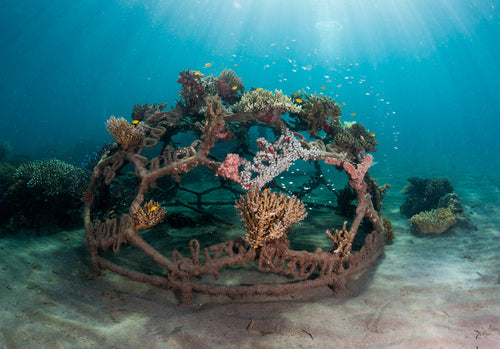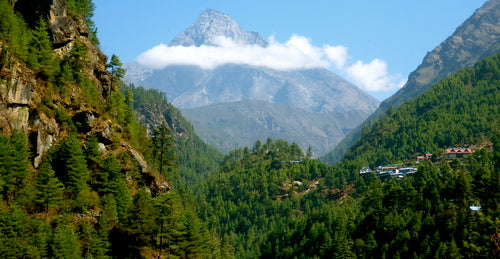EXPEDITION EXCITEMENT
Diving into the sheer blue, 3000m of ocean plunging straight down below us, we levelled off at around 25m, with just the hint of the reef in sight in the far distance. We were on the search for big stuff – Mola Mola, Tiger sharks, Thresher sharks, Hammerhead sharks, Whalesharks, but most especially Oceanic Manta Rays and Reef Manta Rays on an expedition with Guy Stevens, Manta Man/founder and chief executive of The Manta Trust, www.mantatrust.org.
Our liveaboard was moored in the protected harbour of the smallest atoll in the Maldives, Fuvahmulah. No more than a tiny island of around 4 square km, it lies within the Equatorial Channel between Addu Atoll, some 36 miles to the southwest, and Huvadhoo Atoll, some 55 miles to the north. The waters surrounding the atoll reach depths of up to 3000m and swarm with rich sways of plankton brought up from the depths below. This is where the big stuff play, and we were on a mission with Guy to take tissue samples and photo ID’s.

OCEANIC MANTAS WERE ONLY CLASSIFIED AS A SEPARATE SPECIES FAIRLY RECENTLY, IN 2008.
They are much larger than reef mantas, growing up to a 7m as opposed to a 3.5-4m, wingspan. In both species the wing span is roughly 2.2 times the length of the body. They are cartilaginous elasmobranch fishes, closely related to sharks and other rays. They are plankton eating rays, and must keep moving in order to keep water flowing over their gills, which means they can never stop to sleep or rest on the seabed.
They are ocean wanderers, they follow the highway of the ocean currents, traveling vast distances in search of seasonal planktonic blooms. Very little is know of these giants, mainly because they are so difficult to find, spending most of their time in the open ocean far away from land. Each year only a few dozen oceanic mantas are recorded visiting the Maldives. The researchers have never see the same oceanic manta more than once. It is believed the population recorded in the Maldives travel vast distances over hundreds of miles, across the Indian Ocean.
The current was fairly strong, we were having to fin fairly hard just to stay in position, but extremely hard to make any headway into the blue, otherwise we would be swept onto the reef and spat out on the other side of the atoll with nothing between one of the remotest islands in the Southern Maldives, and Africa!
BILLOWING, SMOG-LIKE, THICK CLOUDS OF KRILL GAVE PROMISES OF GIANTS.

Diving in a group of five with our guide, Ashraff, two of our group, Chris and David made an error of judgement, swimming too close to the reef – they were sucked over it, ending their dive prematurely. We had been told to inflate our SMB’s and get to the surface as soon as possible after our safety stop – they didn’t want to be searching for us on the way to Africa!
Keeping close to our guide, we peered through the murk, scanning the whole water column as far as our eyes would let us. The occasional white tip would pass by below. A lone silvertip shark and tiger shark, cruising past way below us, sent our hearts racing. All too soon, our air depleted and our deco limit below 5, we stopped finning and allowed the 3 knot current to carry us over the reef, ascending to our safety stop whilst inflating the essential SMB.
This was hardcore, high risk diving, in incredibly remote areas, with little reward most of the time, however, as the saying goes, ‘you’ve got to be in it to win it’.
Sivad, Guy’s friend of 10 years, who used to work with Guy on the Four Seasons Explorer, was a local of the island and had, along with Guy, dived extensively around the atoll trying to locate the oceanic mantas, joined us for the next days diving. He had spoken to local fishermen to find out if any mantas had been spotted. After a hearty breakfast, we were back on the dhoni preparing to drop into the blue, all excited by the prospect of a more successful day having Sivad on board.
The group before us dropped, but were immediately caught in the increasing current and surfaced straight away, whilst flying over the top of the reef. We picked them up, our excitement tinted by apprehension and nervousness. The dhoni repositioned and we dropped down with almost a negative entry, barely a second or two on the surface just to grab my camera from the boat crew.
Finning much harder than the previous day, to keep away from the reef, we repeated our scans into the blue. Skipjack and yellowfin tuna, milkfish and rainbow runners skirted around us, whilst the odd white tip shark hunted back on the reef, just visible in the distance. Sticking close to Guy, our eyes on stalks trying to spot the elusive giants, suddenly in the distance we saw a shadow approaching. Finning with all our might, we closed the distance.
HEARTS POUNDING,
the fish materialized – not the 6-7m wingspan of a graceful 2 ton oceanic manta, but the huge 3m vertical wingspan of an oceanic sunfish. Seeing our bubbles, it sped off in the opposite direction seemingly at the speed of light – so surprisingly fast for such an awkward looking creature. Guy was pummeling the air with his fist, grinning beneath his regs from ear to ear, giving people high 5’s. Back on the dhoni, he excitedly told us it was his first sight of a sunfish – a man with thousands and thousands of dives, a marine biologist and conservationist, jumping around like a small boy at the one fish he had yet to see.

Our expedition continued on, winding it’s way up from the very Southern most atolls of the Maldives, zig-zagging it’s way across the open sea from East to West, to North Male Atoll.
Guy had told me we had the best chance of seeing oceanic mantas at Fuvahmulah, however there was still the chance to see them in the channels of other Southern atolls. After 4 dives hanging in the blue off Fuvahmulah, we gave up our search and decided to look elsewhere. As is the want of nature, behaviour can never be predicted, and, for some reason, the oceanic’s, which had been there only 10 days before, had disappeared.
Diving at Mudakan in Addu Atoll, we came across a reef manta cleaning station. This area was unusual as the mantas line up rather like airplanes waiting to land, rather than the usual pattern of swimming round and round waiting to be cleaned. Most of the reef mantas here are large juveniles – only a few adults have been recorded. Guy isn’t sure why. It is one of the mysteries surrounding manta rays.
DESCENDING DOWN TO 20M, WE HOOKED INTO THE REEF IN THE MEDIUM TO STRONG CURRENT AND WATCHED WHILST THE MANTAS STAGGERED THEMSELVES OVERHEAD.

None came particularly close, obviously not used to divers in this remote corner of the Maldives. Eagles rays and four large Napolean wrasse also came to be cleaned. We took photos of the underbellies of the mantas, a way of photo Id’ing them through the unique patterns formed by spots and splodges, similar to finger prints. Back on the liveaboard, Guy found 6 mantas already on the database, but one new one, with a very pale coloured back, a male juvenile.
Guy explained that each of the atolls in the Southern Maldives have their own population of reef mantas. There was thought to be no crossover from the mantas swimming from one atoll to the next. However, just after I left the expedition, Guy saw a reef manta at Mudakan which had swam 700km from Hanifaru all the way down to Addu Atoll! This is the world’s largest known migration for this species so far. It has made Guy have to re think his theory on the migrations of these animals – ‘this is why he loves mantas!’, he says.
In the more Northern atolls, however, there is much more crossover, with some mantas crossing from North Male Atoll right up to the northern most atolls and back again, crossing over from the east to west as well. He thinks this is because there are very deep waters between the southern most atolls, roughly around 3000m, whereas, the further north you go, the shallower the channels between atolls, because of a submerged ridge running all the way from Ari Atoll to the far north of the Maldives, at around 300m.
In Addu Atoll, due to the Manta Trust research 47 reef mantas have been identified, nearly all juveniles and sub-adults. In LaamuAtoll, they have identified 20, in Ari, over 500 and in North Male around 500. In Thaa atoll, they haven’t found any. In Baa Atoll there are also close to 1550 mantas that have been identified! We dived in Meemu Atoll, and managed to identify one new reef manta, bringing the total there to 14. The crossover starts north of Meemu Atoll, which is why there appears so many more mantas in Ari and North Male. So far, through photo ID’ing the bellies of mantas, more than 2800 individual mantas have been recorded throughout the Maldives. This is comprised of over 20,000 sightings over the last 10 years.
A LOT OF THE DIVING IN THE SOUTH IS EXPLORATORY DIVING.
Local islanders and fishermen are asked by Guy and his large network of friends, to tell them of any sights of manta rays. Guy had been told by a friend of his who had started working in the Laamu Atoll recently, that mantas had been sighted very close to one of the islands. We decided it was worth a look. What ensued was a beautiful dive, incredibly full of life, with a huge school of batfish accompanying us during the whole of the dive, a group of large remoras looking for a ride on our wetsuits, and a large coral boulder swarming with schools of fish where a graceful reef manta lazily swam whilst being cleaned by the ever busy cleaner wrasse.

As we made our way up the chain of islands, crossing from atoll to atoll, we dived some extreme channels in our search for oceanic mantas. We saw countless black tip, white tip and grey reef sharks. Barracuda, tuna and jacks schooled in their hundreds. At one channel, Nilandhoo Kandu, we hit a 4 knot current and felt completely out of control as we tried to hook into the reef on the corner of the channel at 33m. After only seconds the current swept us up and over the top of the reef at 20m, our no deco reached in minutes, but not before we had seen a massive giant hammerhead effortlessly swimming against the current as if it was a stroll in the park. Unfortunately, my camera was useless, I was unable to fight the current enough to bring the camera in front of me to take a shot – I was having trouble just keeping my mask on!
The next dive, the our dive guide jumped in to check the current and told us it was even stronger. I opted to leave the camera behind, hopefully giving me a few more minutes of air in my tank, without having the huge amount of drag a full DSLR kit produces. Just as well, the current was so strong it ripped my reef hook to pieces. I flew back over the reef, frantically trying to alert my dive buddy, Mateusz. Luckily he heard me, and released himself, his own reef hook fairly battered and out of shape. The current took us up over the reef into the channel itself. Thankfully, it was an ingoing current so we got swept towards the centre of the atoll instead of out to sea. After several minutes of flying along at around 22m, we started to ascend to our safety stop, only to find ourselves suddenly being caught up in a down current taking us from 9m to 33m in seconds. Fighting our way up, with our BCD’s inflated, we eventually managed to reach 5m and stay there for barely 3 minutes before, before, with a breath of relief, we surfaced to see the dhoni not too far away.
The other divers who had managed to stay hooked into the reef for a couple of minutes more than us, saw huge groups of grey reef sharks, a tiger shark and a hammerhead! Oh, for a decent reef hook!
AS THE LIVEABOARD VENTURED FURTHER NORTH, OUR CHANCES OF SEEING THE OCEANIC MANTAS BECAME LESS AND LESS.
Guy had hoped to be able to get close enough to take some tissue samples, his kit with him on every dive just in case, as well as photo id’s. He was hoping to deploy tagging devices to the mantas as well. Unfortunately, the permit to tag didn’t arrive in time for the expedition funds.
So little is known about these beautiful, graceful creatures. Finding out more about them is paramount for their survival. Awareness brought about by research will, hopefully, stop the terrible and significant threats posed by humans and our activities. Recently, mantas have become a desirable and very profitable catch in a number of countries around the world. The reason for this increase in demand is the manta ray’s gill plates, or rakers, have become highly desirable in the Chinese medicine trade. Understanding the mantas life history, threats, reproduction and movements are all crucial in understanding what kind of conservation measures are required. Both oceanic and reef mantas have recently been reassessed for the IUCN Red List and are both considered to be ‘vulnerable’.
There is also brilliant news of the manta listing on CITES (the Convention on International Trade in Endangered Species), which happened just after my expedition, when Guy flew to Thailandto attend the convention. The world’s nations overwhelmingly voted to regulate trade in manta rays, a vital step towards the sustained use and conservation of these magnificent species globally. The Manta Trust team have worked extremely hard for the last three years to stop the global population declines of up to 86% due to a growing market for their gill plates. 80% of the world’s 178 member states which were present voted in favour of the proposal, well over the two thirds majority needed for mantas to gain protective status.
On our expedition continued, diving in some incredible tough currents, in channels where the open ocean squeezed into the atolls through narrow channels. Alas with no oceanic mantas in sight. We were lucky enough to see many reef mantas, taking ID shots of their bellies, discovering several new, unrecorded individuals. In Ari Atoll we had many, many reef mantas skimming over our heads, again and again, seemingly inviting contact and being curious enough to virtually touch our camera dome ports.

ONE NIGHT, WHILST WE WERE MOORED UP IN THE MIDDLE OF THAA ATOLL, GUY ORGANISED FOR A HIGH POWERED LAMP TO BE HUNG OUT OVER THE BACK OF THE BOAT AT DUSK.
During dinner, as the skies grew darker and darker, we were amazed to find a huge ball of plankton materialise under the light. Guy explained that the plankton was attracted to the light. He was hoping this ball might attract a much, much larger, fish as well – a whale shark!
He told us he had experimented with this before with some success. On the last expedition, they had had a whale shark come to feed in the middle of the night.
Gallons of coffee drunk, we all hunkered down to wait, watching the mesmerizing ball of tiny krill swirling around like a cyclone, beneath the power lamps. Strangely soothing, and incredibly peacefully, time seemed to stand still under the dark skies littered with bright stars. The occasional needle fish darted in to claim a mouthful of krill. Just on the edge of darkness we could see several dolphins breaking the surface, trying to pluck up courage to enter the lights beam.
Around 11.30pm, lulled almost to sleep by the hypnotising effect of the gentle swaying of the boat at the swirling ball of krill, the sudden cry of ‘whaleshark!’, had us jumping out of our skins. One of the crew had spotted a whaleshark off the corner of the boat. We all craned our necks over the edge of the duckboard, on tip toes trying not to fall in whilst desperately searching the darkness surrounding the boat.
There, before our eyes, the whaleshark swam straight up, vertically, under the bright lights, taking a huge gulp of plankton, before turning round and round scooping and sucking huge scoopfuls of it’s favourite food into it’s gaping mouth.
Totally oblivious to us, we slipped into the sea, fins, mask and snorkel donned, cameras in hand. Three at a time, we took turns throughout the night, whilst the whaleshark stayed and gorged himself like some ‘eat as much as you can’ buffet. Gulp feeding, sucking huge mouthfuls of plankton rich water into his gills, filtering them through his gill plates, he , greedily hoovered up the enormous feast. At the first hint of dawn, the plankton huge ball now just a small blob in the ocean, the whaleshark turned one last time, slurping the last crumbs on the plate, before submerging into the black, inky depths.
By Lisa Collins
Stay in the loop
Subscribe to our newsletter.
Listen to the Earth The Gone West Show
For every subscriber we get, we plant a native tree alongside our Plant and Protect project partners and communities across the globe.
Everyone loves to get away, especially after two long years of a global pandemic. From city breaks to countryside getaways, we’re all itching to get out and about and [...]
June 23, 2022
Zero-waste living has been on the rise for quite a fews years. The movement started gaining traction when the public were made more aware of the severity of the [...]
May 15, 2022
As the world is getting back to normal and we’re beginning to travel more freely without restrictions, it’s a good time to start thinking more eco-consciously when planning your [...]
April 30, 2022
We’re sure that you, like us and many other people, are entirely burned out by bad news. Whether it’s bad news about politics, the economy, or the environment, we’ve [...]
April 14, 2022
We’re a few weeks into the Winter Olympics, with people from all over the world participating, attending, and tuning in. The event is all about celebrating people and their [...]
February 17, 2022







